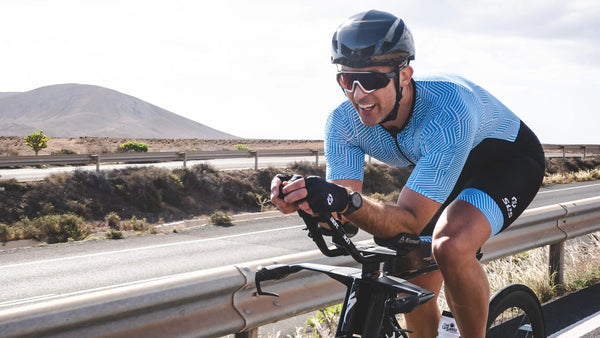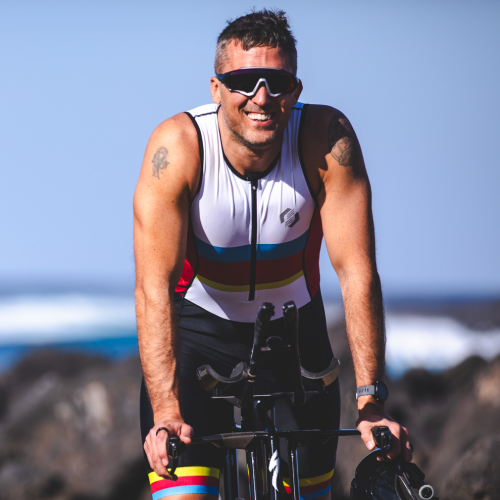Your Cart
You are $50.00 away from FREE SHIPPING
FREE shipping on orders over $50
30 day moneyback guarantee
No Fuss Returns

jim cissel
April 29, 2024

You’ve probably had a friend or relative talk about doing a triathlon or sharing pictures on social media. You might even kind of know what it is, but we’re here to help you clear any confusion. What is Triathlon exactly?
Here's everything you need to know about Triathlon: the what, where, and why to begin your athletic journey today.
A triathlon is a multisport race that combines swimming, biking, and running – in that specific order, over a particular distance. There are short breaks between each transition where the athlete must prepare for the next phase of the race.
How long is a Triathlon, and what distances are covered? Here are the most popular Triathlon race distances:
Super-Sprint Triathlon: The super-sprint triathlon is the shortest triathlon event organized for all the entry-level triathletes. A short distance for the super-sprint involves a 0.25-mile (0.4km) swim, 6.2 miles (9.98km) of biking, and a 1.5-mile (2.41km) run.
Sprint Triathlon: A Sprint-distance triathlon is a mini-triathlon consisting of half the Olympic distances. The sprint Triathlon includes a 0.5-mile (0.8km) swim, 12.4-mile (19.96km) cycling, and a 3.4-mile (21.57km) run.
Olympic-Distance Triathlon: The standards set for the Olympic-distance triathlon by the Olympic games involve 0.93 miles (1.5km), a cycling route across 24.8 miles (39.91km), and a run of 6.2 miles (9.98km).
Half-Ironman Triathlon: A half-Ironman is exactly what the word says: It’s a shorter version of the Ironman championship covering 1.2 miles (1.93km) of swimming, 56 miles (90.12 km) of cycling, and a 12.1-mile (19.47km) run.
Full Ironman Triathlon: The Ironman triathlon is a full-distance sport that involves 2.4 miles (3.8 km) of Swimming, 112 miles (180 km) of biking, and a runners’ marathon of 26.2 miles (42.2 km) to finish. Originating in Hawaii, this championship is one of the most relentless of all.
Triathlon distances are not a one size fits all deal, the above are simply the most popular, however, due to course size and set-up, many triathlons have their own unique distances.
Transition is simply where Triathletes get ready for the next phase of the race. Typically the race consists of two transitions, commonly referred to as “T1 and T2.”
T1, or Transition 1, is after you finish the swim and change into your bike clothing, and start the second stage of the triathlon i.e, cycling. Some races have a tent to change in, while others, you are expected to get ready next to your bike. Having a triathlon specific suit or shorts is one way to make this change over easier and quicker.
Also, a triathlon transition mat is very handy.
Tip: It’s highly recommended to take your time before starting the race to familiarize yourself with your bike’s T1 location. Knowing where your bike is will make life easier when you get done with the swim.
T2, or Transition 2, starts after the bike leg. You dismount your bike as fast as possible, gather your running shoes and accessories, and take off for the run.
Fast and efficient is the goal. Triathlon distances vary according to the race, but being quicker in your transitions is one of the easier ways to save time in your race.
Just like every other sport, here are the most important rules of the triathlon:
✓ Your bikes and gear are inspected before starting the race (like handlebars, brakes, and helmets) to ensure they are roadworthy and appeal to the safety standards.
✓ Depending on the temperature of the water, wetsuits are optional. Each race has its own standards for what temperature is okay for a wetsuit. To keep it simple, if the water is cold, you can wear a wetsuit, and if the water is warm, you cannot.
✓ Each race has its own rules; however, most triathlons do not allow drafting on the bike. What’s drafting? Drafting is a technique used to reduce wind resistance and increase speed by riding closely behind fellow cyclists. If drafting is not allowed, you can incur a penalty and even disqualification for riding too closely. Make sure you understand the drafting rules before starting your race.
✓ Road laws must be followed while on bikes (be it on or off-road), including following restrictions for crossing the white line onto the opposite side of the road.
✓ While exiting T1, triathletes are expected to get on the bike (after) passing the mount line. The mount line is drawn on the road with marshals at the end to closely monitor the line that has been crossed. Similarly, participants must dismount the bike before crossing the dismount line.
✓ The last one is about the headphones. Unlike other races, the use of headphones in almost any triathlon is prohibited.
There are no certain rules for getting started in Triathlon. You can start right away by choosing the distance you want to race. There are a few basic things you’ll need to take part in any triathlon.
However, some races might require a bit more, so keep reading the next section to see a more comprehensive list.

You don’t need to break the bank to participate in a triathlon. However, you might Apart from the standard entry fees, here are some costs you need to hold as a bare minimum:
|
Phase |
Gear Needed |
Additionally |
|
Swim |
Swim cap (Could be provided at the race) Swim Goggles WetSuit (If the race is conducted in open water) Swim buoy for safety |
Although buying quality gear will benefit you in the long run, you can hire any equipment if you don’t want to buy them. |
|
Bike |
A Roadworthy Bike Shorts and a top (could be normal shorts and a T-shirt, or bike shorts with a jersey) Proper Socks Cycling or Triathlon Shoes (Trainers are allowed) |
We recommend you run a safety check of all the equipment you use before the race. |
|
Run |
Tri-suit (If not, you may change into a new top and shorts) Trainers/Runners’ shoes |
Race numbers are typically provided by the race organizers. |
Some races might also require the below:
Our SLS3 collection offers all the above-mentioned utility gear. If you’re keen on choosing the ultimate gear, our SLS3 Tri Suits are just right for you.
You can find many race listings on the internet. In the US, websites like USA Triathlon are a good resource for all the upcoming events that are featured under USA-sanctioned races. The participation categories will help you become part of the race regardless of your multisport journey.
Another practical way is to join the local triathlon club to give you that extra boost. It’s worth checking if there are any local clubs you can join close by to make it easier.
Another benefit of joining a triathlon club is that it helps you surround yourself with like-minded people and gain experiences through their valuable advice. Whether you are a beginner or an experienced triathlete, there is always something new to learn in this multisport.
The valuable lessons learned through a good coach will not only cater to your needs for the race but also help you build strength and endurance for later life.
While taking the triathlon distances into account, another crucial part of the race is the terrains and conditions you have to deal with. Triathletes must know their way of dealing with these conditions and completing the race without putting safety at risk.

Most triathlons take place in open water and can take place in a lake, river, or sea, according to the organizers.

While closed-circuit racetracks are making headlines, most triathlons are non-drifting races on open roads with traffic. Triathlons can also have sections called the ‘cross triathlon’. These are the events where you have to take your required mountain bike to the off-road sections of your country in the race.

Similar to biking, running can be either on-road, off-road, or a combination of both. Therefore it’s highly recommended to choose your footwear according to the race. Most races will describe the running trails, so this is not very hard to figure out.
You need more strength on a gnarly and uneven road route compared to a perfectly flat one, even if the distance is equal. Therefore, it’s good practice to understand all the routes before starting the race so you can prepare like no other!
Learning proper techniques for the particular discipline is highly recommended before setting off the line. To get the most out of it, good gear will always keep you one step ahead of your valuable time in a race where each second matters.
Triathlon is ever-growing due to its reasons and benefits. Whether your goal is to maintain a strong physique or lower your stress hormones, you just need to Get, Set, and go Tri!

CEO, Avid Triathlete
Meet our blog writer and CEO, a true triathlon enthusiast who leads by example. With a personal best of 9 hours and 15 minutes in an Ironman and 9 full-distance Ironman finishes under his belt, he’s as dedicated to the sport as it gets. He didn’t come from an endurance sport background—it wasn’t god-given talent, but rather dedication and hard work that got him to this level. A passionate advocate for optimal nutrition, he’s focused not just on performance but on a healthy, balanced lifestyle. As a father of two boys and a husband, he knows the importance of juggling family, business, and endurance training—and his insights reflect that balance.